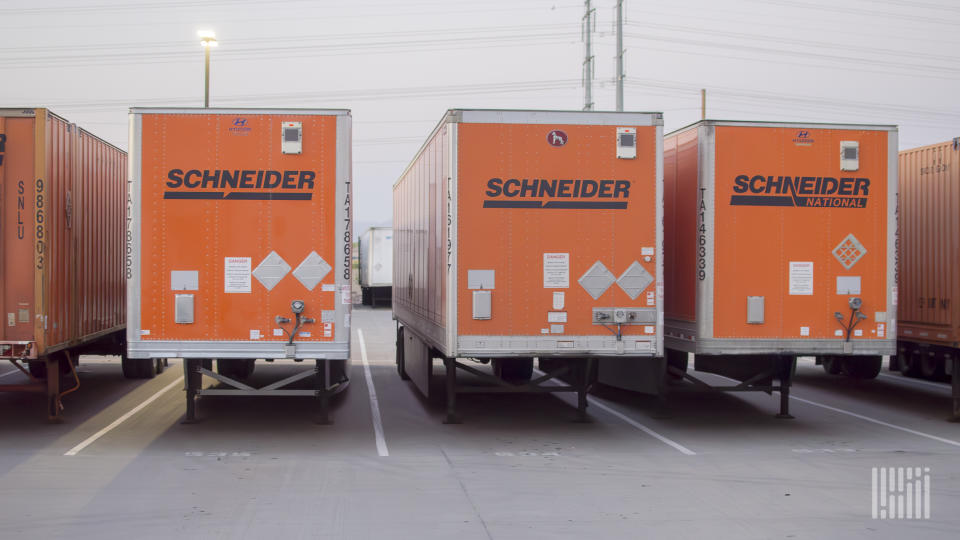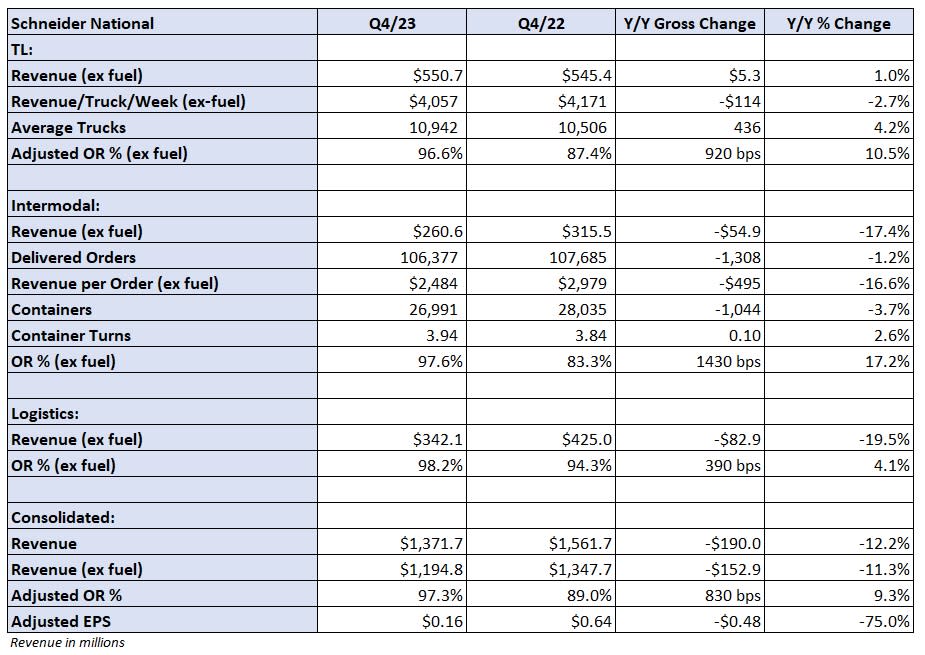Schneider looking for TL market to shake 600-day downturn

Schneider National missed fourth-quarter expectations on Thursday, and its full-year 2024 outlook also came in lower than analysts’ forecasts. The company said it anticipates the truckload market turning, but like many others, believes that won’t happen until the back half of the year.
The company’s internal TL freight index has been below neutral for more than 600 days. The data set shows a normal cycle averages 577 days.
“We believe we’re very long into this cycle. … We do believe things will turn to an extent and we’ll get back into some level of restocking, that’s been stubbornly slow, and capacity continues at a slow and steady pace to exit the marketplace,” said President and CEO Mark Rourke on a call with analysts.
Schneider (NYSE: SNDR) reported fourth-quarter adjusted earnings per share of 16 cents, 4 cents below the consensus estimate and 48 cents lower year over year (y/y). The quarter was dragged down by adverse claims developments stemming from two accidents, which were partially offset by a lower tax rate. The items equaled 4 cents per share. It also lost money on the disposal of equipment compared to gains booked in the prior-year period.
The adjusted EPS number excluded 1 cent from acquisition-related amortization expense.
The full-year 2024 outlook calls for adjusted EPS of $1.15 to $1.30, which was lower than the $1.38 consensus estimate at the time of the print and the $1.37 reported in 2023. The headwinds to the new year include higher insurance and claims expenses, a higher tax rate and a $30 million reduction in gains from equipment sales. The company also booked 9 cents in EPS from gains on equity investments last year and the new guidance includes none.
Tapping more heavily into the cross-border intermodal market given its new relationship with Canadian Pacific Kansas City (NYSE: CP), a variety of productivity initiatives aimed at improving the number of times each piece of equipment gets turned and a minimal investment requirement to accommodate growth were mentioned as some of the positive catalysts for 2024.
Also, management said recent conversations with customers around bid season suggest that many are approaching discussions with the understanding that rates negotiated in the near term may not hold through the year as the market is expected to tighten.
Q4 by the numbers

Truckload revenue was up 1% y/y to $551 million excluding fuel surcharges. Revenue per truck per week fell 3%, the combination of lower pricing in its one-way fleet and steady results in its contract-based dedicated unit. The top-line result also included the August acquisition of M&M Transport Services, which added roughly 500 trucks to Schneider’s dedicated fleet.
Schneider continues to add to its dedicated offering, both organically and through acquisition, while reducing its dependence on one-way, over-the-road trucking. The dedicated fleet was up 11% y/y to more than 6,600 units in the quarter, with the one-way fleet down 5% to 4,300 trucks.
The TL segment recorded a 96.6% adjusted operating ratio, which was 920 basis points worse y/y and 120 bps worse than the third quarter. Higher claims costs and a net loss on the sale of equipment, versus a gain a year ago, were the primary headwinds.
The consolidated income statement showed cost inflation on most lines, led by salaries, wages and benefits expenses, which were up 400 bps as a percentage of revenue. Operating supplies, depreciation and amortization, and insurance and claims expenses were all up by more than 100 bps.
Intermodal revenue fell 17% y/y excluding fuel to $261 million as loads fell 1% and revenue per load dropped 17%. The company had approximately 15% of its container fleet laid up in the quarter due to tepid demand and recent container additions. That trend was also seen by J.B. Hunt (NASDAQ: JBHT), which had 11% of its containers idle during the period.
Both intermodal volumes and yields increased 1% sequentially for Schneider from the third quarter, with management noting volume growth in December.
Intermodal posted a 97.6% adjusted OR, which was 1,430 bps worse y/y and 180 bps worse than the third quarter. The division may see an outsize performance in the next upcycle as incremental costs won’t be required to facilitate growth given recent investments in the business.
Logistics revenue (excluding fuel) was down 20% y/y to $342 million due to lower volumes and revenue per load. The unit reported a 98.2% adjusted OR, which was off 390 bps y/y.
Shares of SNDR were down 3.9% Thursday at 1:03 p.m. EST compared to the S&P 500, which was up 0.8%.
More FreightWaves articles by Todd Maiden
The post Schneider looking for TL market to shake 600-day downturn appeared first on FreightWaves.

